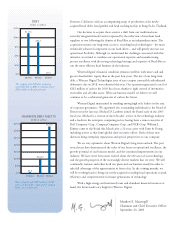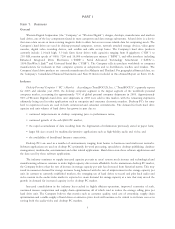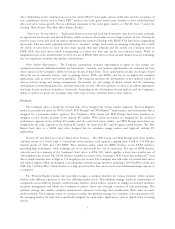Western Digital 2003 Annual Report Download - page 15
Download and view the complete annual report
Please find page 15 of the 2003 Western Digital annual report below. You can navigate through the pages in the report by either clicking on the pages listed below, or by using the keyword search tool below to find specific information within the annual report.The Company's international sales, which include sales to foreign subsidiaries of U.S. companies but do not include
sales to U.S. subsidiaries of foreign companies, represented 59%, 50% and 47% of the Company's revenue for 2003,
2002 and 2001, respectively. Sales to international customers may be subject to certain risks not normally encountered in
domestic operations, including exposure to tariÅs, various trade regulations and Öuctuations in currency exchange rates.
See Part II, Item 7, under the heading ""Risk Factors That May AÅect Future Results.''
For additional information concerning revenue recognition, sales by geographic region and signiÑcant customer
information, see Notes 1 and 8 of the Notes to Consolidated Financial Statements.
The Company's marketing and advertising functions are performed both internally and through an outside Ñrm.
Advertising, worldwide packaging and marketing materials are targeted to various reseller and end-user segments.
Western Digital utilizes both consumer media and, to a lesser extent, trade publications. The Company has programs
under which qualifying distributors and retailers are reimbursed for certain marketing expenditures. Western Digital also
maintains customer relationships by communicating with its resellers and providing end-users with pre-sale and post-sale
information and support through its web site.
Competition
The Company competes primarily with manufacturers of 3.5-inch hard disk drives for desktop and server
computers. The Company's competitors in the hard drive market include Fujitsu, Hitachi Global Storage Technologies
(a joint venture formed in 2003 between Hitachi and IBM), Maxtor, Samsung and Seagate. Over the last three years,
the hard drive industry has experienced consolidation, decreasing the number of major competitors. In particular, Maxtor
acquired the hard drive business of Quantum, Fujitsu exited the desktop hard drive market, and IBM sold its hard drive
business to Hitachi Global Storage Technologies.
The hard drive industry is intensely competitive, with hard drive suppliers competing for sales to a limited number
of major customers. Hard drives manufactured by diÅerent competitors are highly substitutable due to the industry
mandate of technical form, Ñt and function standards. Hard drive manufacturers compete on the basis of product quality
and reliability, storage capacity, unit price, product performance, production volume capabilities, delivery capability,
leadership in time-to-market, time-to-volume and time-to-quality, service and support, and ease of doing business. The
relative importance of these factors varies between diÅerent customer and market segments. The Company believes that it
is generally competitive in all of these factors.
Based on quarterly reports published by TrendFOCUS in 2003 and calendar year 2002, the Company believes that
its market share of hard disk drives sold worldwide during 2003, based on units shipped, increased approximately 4%,
from approximately 13% to approximately 17%. During 2003, Western Digital, Seagate, Maxtor, and Hitachi Global
Storage Technologies (including sales by IBM and Hitachi prior to the formation of the joint venture in 2003) supplied
approximately 85% of the total hard drive market.
The Company believes that there are no substantial barriers to entry for competitors to oÅer competing products.
Therefore, the Company believes that it cannot diÅerentiate its hard drive products solely on attributes such as storage
capacity, buÅer size or time-to-market. Accordingly, the Company also diÅerentiates itself by designing and incorporating
into its hard drives desirable product performance attributes, focusing on seek time, data transfer rates, intelligent
caching, failure prediction, remote diagnostics, acoustics and data recovery. In addition, the Company emphasizes non-
product related attributes, including rapid response with its computer manufacturer and distribution customers. Rapid
response requires accelerated design cycles, customer delivery, production Öexibility and timely service and support, which
contribute to customer satisfaction. The Company also relies on the strength of the Western Digital brand name with
value-added resellers and solution providers to whom the Company sells its hard drive products directly and indirectly.
The Company believes that trust in a manufacturer's reputation and the establishment of strategic relationships have
become important factors in the selection of a hard drive, particularly within such a rapidly changing technology
environment.
The desktop hard drive market is characterized by several large competitors; therefore, it has traditionally been
subject to periods of sustained and severe price competition, and factors such as time-to-market, time-to-volume and
time-to-quality can have a pronounced eÅect on the success of any particular product.
9
























